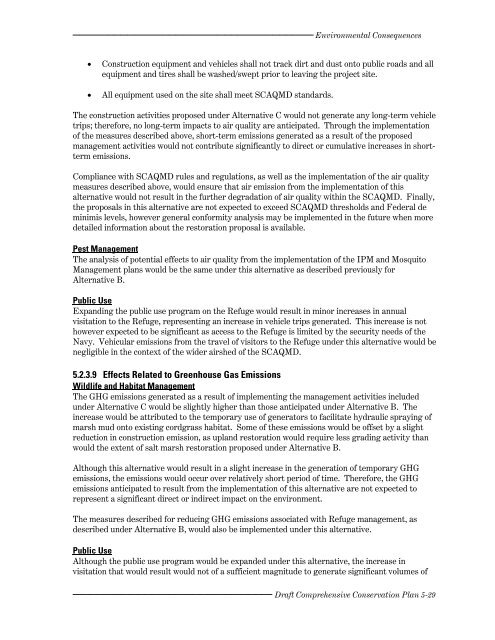Chapters 1 - U.S. Fish and Wildlife Service
Chapters 1 - U.S. Fish and Wildlife Service
Chapters 1 - U.S. Fish and Wildlife Service
Create successful ePaper yourself
Turn your PDF publications into a flip-book with our unique Google optimized e-Paper software.
Environmental Consequences<br />
Construction equipment <strong>and</strong> vehicles shall not track dirt <strong>and</strong> dust onto public roads <strong>and</strong> all<br />
equipment <strong>and</strong> tires shall be washed/swept prior to leaving the project site.<br />
All equipment used on the site shall meet SCAQMD st<strong>and</strong>ards.<br />
The construction activities proposed under Alternative C would not generate any long-term vehicle<br />
trips; therefore, no long-term impacts to air quality are anticipated. Through the implementation<br />
of the measures described above, short-term emissions generated as a result of the proposed<br />
management activities would not contribute significantly to direct or cumulative increases in shortterm<br />
emissions.<br />
Compliance with SCAQMD rules <strong>and</strong> regulations, as well as the implementation of the air quality<br />
measures described above, would ensure that air emission from the implementation of this<br />
alternative would not result in the further degradation of air quality within the SCAQMD. Finally,<br />
the proposals in this alternative are not expected to exceed SCAQMD thresholds <strong>and</strong> Federal de<br />
minimis levels, however general conformity analysis may be implemented in the future when more<br />
detailed information about the restoration proposal is available.<br />
Pest Management<br />
The analysis of potential effects to air quality from the implementation of the IPM <strong>and</strong> Mosquito<br />
Management plans would be the same under this alternative as described previously for<br />
Alternative B.<br />
Public Use<br />
Exp<strong>and</strong>ing the public use program on the Refuge would result in minor increases in annual<br />
visitation to the Refuge, representing an increase in vehicle trips generated. This increase is not<br />
however expected to be significant as access to the Refuge is limited by the security needs of the<br />
Navy. Vehicular emissions from the travel of visitors to the Refuge under this alternative would be<br />
negligible in the context of the wider airshed of the SCAQMD.<br />
5.2.3.9 Effects Related to Greenhouse Gas Emissions<br />
<strong>Wildlife</strong> <strong>and</strong> Habitat Management<br />
The GHG emissions generated as a result of implementing the management activities included<br />
under Alternative C would be slightly higher than those anticipated under Alternative B. The<br />
increase would be attributed to the temporary use of generators to facilitate hydraulic spraying of<br />
marsh mud onto existing cordgrass habitat. Some of these emissions would be offset by a slight<br />
reduction in construction emission, as upl<strong>and</strong> restoration would require less grading activity than<br />
would the extent of salt marsh restoration proposed under Alternative B.<br />
Although this alternative would result in a slight increase in the generation of temporary GHG<br />
emissions, the emissions would occur over relatively short period of time. Therefore, the GHG<br />
emissions anticipated to result from the implementation of this alternative are not expected to<br />
represent a significant direct or indirect impact on the environment.<br />
The measures described for reducing GHG emissions associated with Refuge management, as<br />
described under Alternative B, would also be implemented under this alternative.<br />
Public Use<br />
Although the public use program would be exp<strong>and</strong>ed under this alternative, the increase in<br />
visitation that would result would not of a sufficient magnitude to generate significant volumes of<br />
Draft Comprehensive Conservation Plan 5-29

















